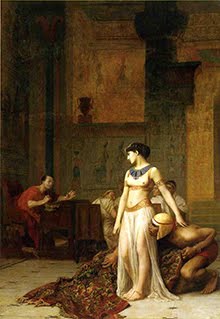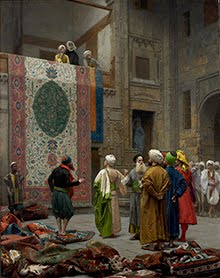Love this new custom rug that I just bought for a client from Turkey.
Take a look at my new website at www.monicafosterinteriors.com
Friday
Monday
Welcome, Leave Your Shoes On

A bit about myself, I am married to a movie and theater producer and the proud mother of a son who grew up too quickly and now attends college. We share our home with Ruby, an adorable, energetic Labradoodle who has finally learned to respect a fine carpet.
I too was a movie producer for quite some time which is where my flair for the dramatic expressed itself. Leaving Hollywood behind, I have embraced my love for drama and beauty through the traditional, but no less exciting art of antique rugs.
 I now enter a room and in my mind's eye cast the perfect rug for the role. Trust me, rugs are far less demanding than actors.
I now enter a room and in my mind's eye cast the perfect rug for the role. Trust me, rugs are far less demanding than actors.A quality Oriental rug is timeless and will, with a slight nod to its environ, add warmth yet shine with a quiet sense of cool in any room whatever the decor. True artisan rugs are works of art that were made to be walked on, just roll them up until your Labradoodle is house trained.
The top image is courtesy of the much missed Domino magazine, bottom image: London catalogue from Christie's rug auction.
Sunday
Always Inspect the Quality of the Weave
 |
| Images courtesy of Twentieth Century Fox |
 Please indulge me for a Hollywood moment, I would like to share with you a celluloid clip that I suspect ignited my love of both film and rugs as an impressionable child.
Please indulge me for a Hollywood moment, I would like to share with you a celluloid clip that I suspect ignited my love of both film and rugs as an impressionable child.The film is of course Cleopatra starring Elizabeth Taylor and in this scene she has cleverly disguised herself as a gift, a carpet, to be presented to Caesar.
Every time a carpet is delivered to my home I restrain myself from rolling up in it. I am not Liz.
Still, talk about making an entrance.
London Calling

Bigger is not always better, it is sometimes breathtaking. If you have never viewed what is perhaps the world's most magnificent and oldest carpet you must head to London's V&A Museum.
The Ardabil Carpet, named after the town in north-west Iran where it was made, measures roughly 10.5 metres by 5 metres. I believe that is 34 ft. by 16 ft. but do not hold me to that. Its size and beauty, together with its outstanding historical significance, makes it the most important carpet in the Victoria and Albert Museum, and one of the finest in the world.
The Museum created an extraordinary case in the center of a gallery so that the carpet could be viewed as intended, on the floor. To preserve its colors, it is lit for ten minutes on the hour and half-hour.
These photographs and my words can never do this work of art justice. Should you find yourself lucky enough to be in London make a point of seeing it, you will not be disappointed.
 |
| Images courtesy of The Victoria and Albert Museum, London. |
Colors to Dye for
Whether your taste in carpets leans towards all-over floral patterns or more primitive tribal designs the first factor in selecting a carpet is color. It’s the beauty of blending colors that creates a harmonious composition that makes Persian carpets so enchanting. Natural dyes are made from vegetables, plants, or animal bases that produce the most luminous, warm and sombre shades.
Among collectors it’s widely agreed upon that synthetic or analine dyes should not be compared to natural dyes. The passage of time and long term effects of using synthetic dye are unpredictable; change of color altogether and dyes eating into the rug are common. It’s clear to see the difference between the lustre and sheen of a naturally dyed antique rug compared to the dull uniform color that is produced through the use of chemical dyes.
There is more to the process than just mixing dye with boiling water. Each plant has its own special properties and the dyer skillfully and knowledgeably prepares the yarn accordingly. The dyers craft is an ancient one passed down through generations, father to son. He is an artisan whose traditions and secrets are highly regarded.
The sources of these natural dyes are both logical and at times surprising.
 Shades of red are derived from the crushed roots of madder; a climbing plant that grows wild over much of the East. It belongs to the genus Rubia whose roots contain three coloring matters, alizarin and purpurin which are both red, and xanthin which is yellow. More vivid reds were introduced in 1856 with the import of Cochineal, a female bug of the species Dactylopius coccus which lives on cactus. If you have ever marveled at the bright red color of your Campari and soda, well, thank the Cochineal!
Shades of red are derived from the crushed roots of madder; a climbing plant that grows wild over much of the East. It belongs to the genus Rubia whose roots contain three coloring matters, alizarin and purpurin which are both red, and xanthin which is yellow. More vivid reds were introduced in 1856 with the import of Cochineal, a female bug of the species Dactylopius coccus which lives on cactus. If you have ever marveled at the bright red color of your Campari and soda, well, thank the Cochineal!
Saffron, tumeric, sumac and the fruit of Perisan buckthorns are used for yellows.
Greens are produced by combining indigo with yellow though Chinese green dye is obtained from Rhamnus chlorophorus, a genus of shrubs.
Different blue tones are made from the leaves of the indigo plant. The color is achieved by both the number of times the yarn is immersed in the dye vat as well as the length of dyeing time.
Tyrian purple dye is found in shellfish. Who knew?
Henna yields orange, beige is made from barley while black, brown and grey dyes are mainly made from the shells, leaves and husks of nut trees.
The dyeing process starts with the preparation of the color. Sometimes curds or sour milk is mixed into the dye to achieve lighter colors, the color is then diluted in a vat. The quantity of water varies based on the desired shade. The wool is then placed in boiling water and after being heated for the desired amount of time the wool is allowed to cool in the dye. The final stage in the dyeing process is to make the color fast. Once the carpet is ready, it is immersed in cold water to rinse any excess coloring and finally laid out in the sun to dry.
Variations in color, streaked or uneven shading known as abrash, or changes in the dye lot due to the quality of water or texture of wool, add to the charm and life of the rug. Natural dyes age in a graceful way, producing a mellow, faded color palate that remains unrivaled.
Among collectors it’s widely agreed upon that synthetic or analine dyes should not be compared to natural dyes. The passage of time and long term effects of using synthetic dye are unpredictable; change of color altogether and dyes eating into the rug are common. It’s clear to see the difference between the lustre and sheen of a naturally dyed antique rug compared to the dull uniform color that is produced through the use of chemical dyes.
There is more to the process than just mixing dye with boiling water. Each plant has its own special properties and the dyer skillfully and knowledgeably prepares the yarn accordingly. The dyers craft is an ancient one passed down through generations, father to son. He is an artisan whose traditions and secrets are highly regarded.
The sources of these natural dyes are both logical and at times surprising.
 |
| The Rug Merchant by Addison Thomas Miller, below: an example of a natural red dye made from the Cochineal insect. |
 Shades of red are derived from the crushed roots of madder; a climbing plant that grows wild over much of the East. It belongs to the genus Rubia whose roots contain three coloring matters, alizarin and purpurin which are both red, and xanthin which is yellow. More vivid reds were introduced in 1856 with the import of Cochineal, a female bug of the species Dactylopius coccus which lives on cactus. If you have ever marveled at the bright red color of your Campari and soda, well, thank the Cochineal!
Shades of red are derived from the crushed roots of madder; a climbing plant that grows wild over much of the East. It belongs to the genus Rubia whose roots contain three coloring matters, alizarin and purpurin which are both red, and xanthin which is yellow. More vivid reds were introduced in 1856 with the import of Cochineal, a female bug of the species Dactylopius coccus which lives on cactus. If you have ever marveled at the bright red color of your Campari and soda, well, thank the Cochineal!Saffron, tumeric, sumac and the fruit of Perisan buckthorns are used for yellows.
Greens are produced by combining indigo with yellow though Chinese green dye is obtained from Rhamnus chlorophorus, a genus of shrubs.
Different blue tones are made from the leaves of the indigo plant. The color is achieved by both the number of times the yarn is immersed in the dye vat as well as the length of dyeing time.
Tyrian purple dye is found in shellfish. Who knew?
Henna yields orange, beige is made from barley while black, brown and grey dyes are mainly made from the shells, leaves and husks of nut trees.
The dyeing process starts with the preparation of the color. Sometimes curds or sour milk is mixed into the dye to achieve lighter colors, the color is then diluted in a vat. The quantity of water varies based on the desired shade. The wool is then placed in boiling water and after being heated for the desired amount of time the wool is allowed to cool in the dye. The final stage in the dyeing process is to make the color fast. Once the carpet is ready, it is immersed in cold water to rinse any excess coloring and finally laid out in the sun to dry.
Variations in color, streaked or uneven shading known as abrash, or changes in the dye lot due to the quality of water or texture of wool, add to the charm and life of the rug. Natural dyes age in a graceful way, producing a mellow, faded color palate that remains unrivaled.
Subscribe to:
Posts (Atom)






